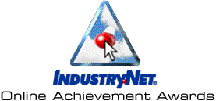|
Award Winning, The online MacinStuff Times | | The
online MacinStuff Times |
| Currently ranks is
138 out of 158,067 sites | | rated in the top
1% of all Web
Counter sites |
| | Averaging
1,000 readers a day |
Up 129 places since March
11, On Web Counters
 | | Selected
as Aprils Hot Site of the month by  |
Nominated
as "Coolest Site" by IndustryNet
| | The online MacinStuff Times
has had

readers. |

